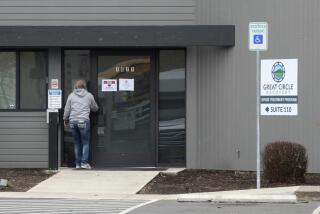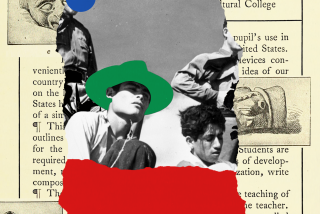‘Oregon Trail’ Debunks Romantic Myths
- Share via
History is told by the victors, but the interesting sea change in current American history-telling is that the vanquished are now allowed to speak.
Traditionalists don’t like this: Remember the firestorm of protest over the Smithsonian’s recent Hiroshima exhibit, which U.S. veterans decried for suggesting that maybe, just maybe, the U.S. did a very bad thing dropping the atom bomb?
Western history traditionalists can’t be very happy, either, with the premiere of the three-hour “In Search of the Oregon Trail” by producer-director Michael Farrell.
Farrell’s main problem is that he isn’t the first to come out on television and suggest that much of what we think we know about the U.S. settlement-conquest of the West is wrong. A great deal of “Oregon Trail” was covered with greater passion, artistry and historical rigor by Ric Burns in his seminal, majestic PBS epic, “The Way West.”
From the cultural conflict between Indian tribes and white Christian families to the deeper political meanings of westward expansion and the personal tales of courage and tragedy, Burns’ work has already grooved a path that Farrell dutifully traces.
What’s different here are the specifics and the program’s stated mission to debunk the old history and the romantic myths that abound about the Oregon Trail. This was the path of the covered wagon parties, supposedly daily attacked by Indians.
Wrong, say new historians like Susan Armitage and Richard White. “Overlanders,” as the immigrants were called, rarely encountered Indians; the biggest enemies were disease and fatigue during the arduous western half of the trail through Wyoming, Idaho, Nevada and Oregon.
Farrell lucidly lays out the story of why thousands dared the trek west, guided by trappers and explorers before them. Economic depression in the East, bankruptcy and the California gold discovery made even Henry David Thoreau equate the West with freedom. The overlanders, though, were as different as their goals: Families took the northern route to Oregon, Mormons fleeing persecution headed for Utah and single men headed south to California.
The real battles between whites and Indians occurred after the overlanders settled in at the end of the trail, and Farrell’s group of historians and Native American commentators speculate on how and why the Oregon Trail romances (epitomized by the early western, “The Covered Wagon”) transferred the bloody land wars from Oregon and California to the trail itself.
Alas, by the time this demystified history gets to the most forgotten passages (such as the Oregon wars between whites and the Nez Perce and other peoples), the viewer feels overwhelmed by the combination of historical analysis, diary readings and Stacy Keach’s narration. On this “Oregon Trail,” you may begin to understand the overlanders’ fatigue all too well.
* “In Search of the Oregon Trail” airs at 8 tonight on KCET-TV Channel 28.
More to Read
Sign up for The Wild
We’ll help you find the best places to hike, bike and run, as well as the perfect silent spots for meditation and yoga.
You may occasionally receive promotional content from the Los Angeles Times.






